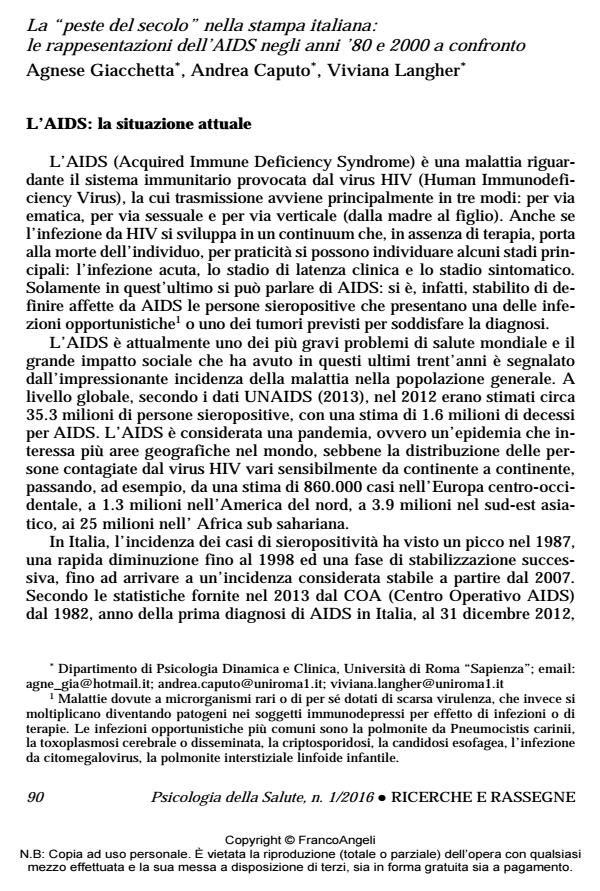The "plague of the century" in the Italian press: Representations of AIDS in the 80’s compared to 2000’s
Journal title PSICOLOGIA DELLA SALUTE
Author/s Agnese Giacchetta, Andrea Caputo, Viviana Langher
Publishing Year 2016 Issue 2016/1
Language Italian Pages 21 P. 90-110 File size 134 KB
DOI 10.3280/PDS2016-001009
DOI is like a bar code for intellectual property: to have more infomation
click here
Below, you can see the article first page
If you want to buy this article in PDF format, you can do it, following the instructions to buy download credits

FrancoAngeli is member of Publishers International Linking Association, Inc (PILA), a not-for-profit association which run the CrossRef service enabling links to and from online scholarly content.
The analysis of social representations played an important role in understanding AIDS and attitudes toward the illness. In particular, research on the representations spread by media detected a historical evolution of the social construction of the phenomenon from ’80s to date. This paper aims at contributing to this debate through exploring the evolution of journalistic discourse on AIDS by comparing two periods (1985-1990 and 2005-2010) in order to detect whether and how representations of AIDS changed over twenty years. The research textual corpus is composed of a sample of 446 articles derived from the Italian newspapers La Repubblica and Corriere della Sera. Specificity analysis allowed the comparison of two sub-corpora consisting in the articles produced between 1985 and 1990 and 2005 and 2010 respectively, in order to detect the typical words characterizing the sub-corpora. Overall, results highlight some differences dealing with a general normalization of the disease: from alarmism characterizing the 80s, discourse on AIDS changes over raising higher public awareness in the 2000’s. From topics such as deviance of specific social groups at risk, the focus on the diagnosis, the problems of public order and the marginalization of the patient, more recent popular press reports different topics such as global health, the therapeutic solutions, epidemiology, the chronicity of the disease and the impact on quality of life.
Keywords: AIDS, Social representations, Text analysis, Mass communication
- Using Emotional Text Mining to Explore the Cultural Representation of Organ Donation in Spanish and Italian Culture Silvia Monaco, Anna Cortellino, Maria Giovanna Massari, Michela Di Trani, Francesca Greco, in Culture & Psychology /2025 pp.259
DOI: 10.1177/1354067X231172909 - Analyzing assisted reproductive treatment representations in Italy and Spain through newspapers Marta Anna Stella Vizzini, Silvia Monaco, Loredana Tetecher, Claudia Cappadonna, Vincenzo Ambriola, Michela Di Trani, Rachele Mariani, in Frontiers in Psychology 1451663/2024
DOI: 10.3389/fpsyg.2024.1451663
Agnese Giacchetta, Andrea Caputo, Viviana Langher, La "peste del secolo" nella stampa italiana: le rappesentazioni dell’AIDS negli anni ’80 e 2000 a confronto in "PSICOLOGIA DELLA SALUTE" 1/2016, pp 90-110, DOI: 10.3280/PDS2016-001009